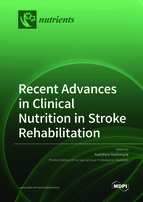Recent Advances in Clinical Nutrition in Stroke Rehabilitation
A special issue of Nutrients (ISSN 2072-6643). This special issue belongs to the section "Clinical Nutrition".
Deadline for manuscript submissions: closed (30 November 2021) | Viewed by 29916
Special Issue Editor
Interests: sarcopenia; frailty; malnutrition; rehabilitation; polypharmacy
Special Issues, Collections and Topics in MDPI journals
Special Issue Information
Dear Colleagues,
Stroke is a common cause of death and disability worldwide. Malnutrition is prevalent in stroke rehabilitation patients, and malnutrition has serious negative effects on outcomes. In addition, there is growing interest in new concepts related to malnutrition, such as sarcopenia, frailty, cachexia, chronic inflammation, dysphagia, and oral problems, all of which contribute to poor prognosis.
Therefore, it is necessary to assess nutritional status early and, if needed, provide appropriate nutritional prevention and treatment to maximize improvement in patient outcomes. In addition, multidisciplinary approach is strongly recommended in this setting. To attain these goals, high-quality clinical evidence is needed regarding clinical nutrition in stroke rehabilitation.
The aim of this Special Issue is to update knowledge on nutritional management, including dietary intervention and diet intake, in patients with stroke. All types of manuscripts, including original articles and reviews, are welcome.
Dr. Yoshihiro Yoshimura
Guest Editor
Manuscript Submission Information
Manuscripts should be submitted online at www.mdpi.com by registering and logging in to this website. Once you are registered, click here to go to the submission form. Manuscripts can be submitted until the deadline. All submissions that pass pre-check are peer-reviewed. Accepted papers will be published continuously in the journal (as soon as accepted) and will be listed together on the special issue website. Research articles, review articles as well as short communications are invited. For planned papers, a title and short abstract (about 100 words) can be sent to the Editorial Office for announcement on this website.
Submitted manuscripts should not have been published previously, nor be under consideration for publication elsewhere (except conference proceedings papers). All manuscripts are thoroughly refereed through a single-blind peer-review process. A guide for authors and other relevant information for submission of manuscripts is available on the Instructions for Authors page. Nutrients is an international peer-reviewed open access semimonthly journal published by MDPI.
Please visit the Instructions for Authors page before submitting a manuscript. The Article Processing Charge (APC) for publication in this open access journal is 2900 CHF (Swiss Francs). Submitted papers should be well formatted and use good English. Authors may use MDPI's English editing service prior to publication or during author revisions.
Keywords
- Malnutrition
- Sarcopenia
- Frailty
- Cachexia
- Chronic inflammation
- Dysphagia
- Oral problems
- Physical function
- Physical disability
- Rehabilitation







